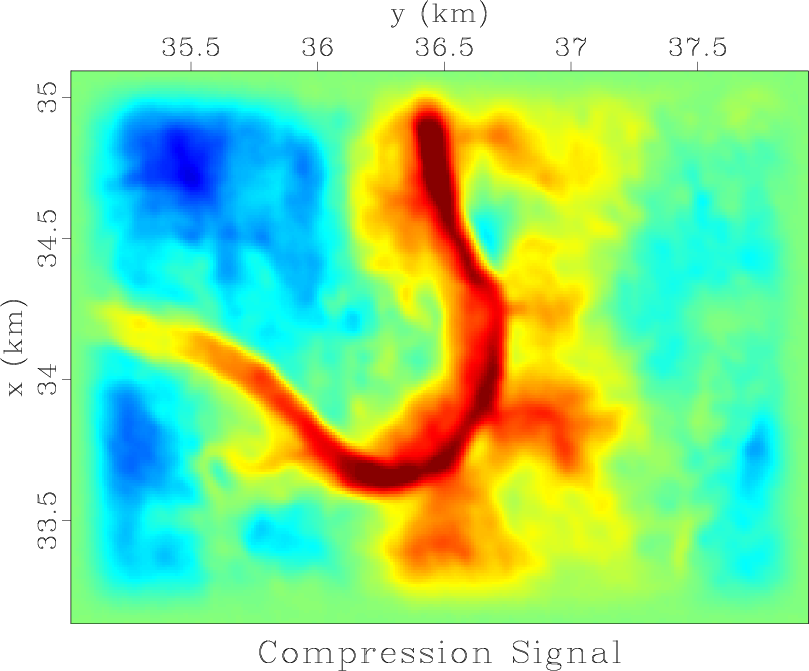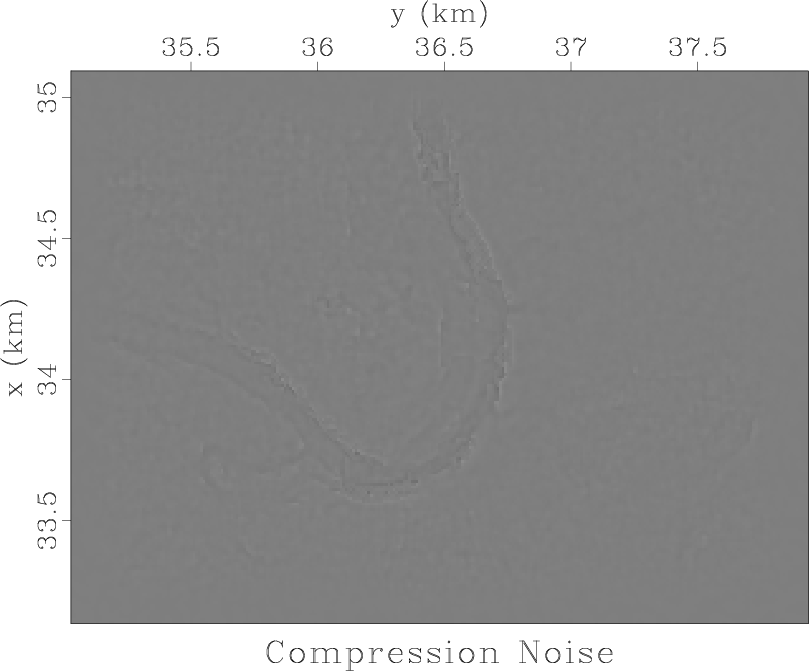|
|
|
|
Homework 3 |
In this exercise, we will use a depth slice selected from a 3-D seismic volume and shown in Figure 3 (Hall, 2007). Notice a channel structure.
|
data
Figure 3. Seismic depth slice with a channel structure. |

|
|---|---|
|
|
|
fft
Figure 4. Absolute value of the Fourier transform of the seismic slice from Figure 3. The circle inside shows a window selected for compression. |

|
|---|---|
|
|
The goal of your assignment is to find a compressed representation of the data in the Fourier transform domain. Figure 4 shows the Fourier transform of the data from Figure 3. We can see that most of the energy gets concentrated near the center (zero frequency).
There are two alternative ways to compress data in the Fourier domain:


|
|---|
|
sig,cut
Figure 5. Data separated into signal (a) and noise (b) by applying Fourier compression with windowing. |
|
|


|
|---|
|
thr,noi
Figure 6. Data separated into signal (a) and noise (b) by applying Fourier compression with thresholding. |
|
|
|
hist
Figure 7. Normalized histogram of Fourier coefficients (by absolute value). The vertical line shows the selected threshold. |

|
|---|---|
|
|
scons viewto reproduce the figures on your screen.
from rsf.proj import *
# Get data
##########
Fetch('horizon.asc','hall')
# Convert format
Flow('data','horizon.asc',
'''
echo in=$SOURCE data_format=ascii_float n1=3 n2=57036 |
dd form=native | window n1=1 f1=-1 | add add=-65 |
put
n2=291 o2=35.031 d2=0.01 label2=y unit2=km
n1=196 o1=33.139 d1=0.01 label1=x unit1=km |
costaper nw1=25 nw2=25
''')
# Display
def plot(title):
return '''
grey color=j title="%s"
transp=y yreverse=n clip=14
''' % title
Result('data',plot('Horizon'))
# 2-D Fourier Transform
#######################
Flow('fft','data',
'rtoc | fft3 axis=1 pad=1 | fft3 axis=2 pad=1')
Plot('fft',
'''
math output="abs(input)" | real |
grey title="Fourier Transform" allpos=y screenratio=1
''')
# A. Compression by Windowing
#############################
cut = 8 # !!! CHANGE ME !!!
# Create a frame
Flow('frame','fft','real | math output="sqrt(x1*x1+x2*x2)" ')
Plot('frame',
'''
contour nc=1 c0=%g plotfat=5 plotcol=3
wantaxis=n wanttitle=n screenratio=1
''' % cut)
Result('fft','fft frame','Overlay')
# Cut a hole
Flow('fcut','frame fft',
'''
mask max=%g |
dd type=float | rtoc |
mul ${SOURCES[1]}
''' % cut)
# Inverse FFT
Flow('sig','fcut',
'fft3 axis=2 inv=y | fft3 axis=1 inv=y | real')
Result('sig',plot('Compression Signal'))
Flow('cut','data sig','add scale=1,-1 ${SOURCES[1]}')
Result('cut',plot('Compression Noise') + 'color=I')
# B. Compression by Thresholding
################################
thr = 80 # !!! CHANGE ME !!!
# Plot histogram
Plot('hist','fft',
'''
math output="abs(input)" | real |
histogram o1=0 d1=%g n1=101 |
dd type=float | scale axis=1 |
bargraph title="Scaled Histogram" pad1=n
label1= unit1= label2= unit2=
''' % (0.03*thr))
Flow('line.asc',None,
'echo 0 0 0 1 n1=4 data_format=ascii_float in=$TARGET')
Plot('line','line.asc',
'''
dd type=complex form=native |
graph min1=-1 max1=2 plotcol=5
wantaxis=n wanttitle=n dash=1
''')
Result('hist','hist line','Overlay')
# Thresholding
Flow('fthr','fft','thr thr=%g' % thr)
# Inverse FFT
Flow('thr','fthr',
'fft3 axis=2 inv=y | fft3 axis=1 inv=y | real')
Result('thr',plot('Compression Signal'))
# Subtract from Data
Flow('noi','data thr','add scale=1,-1 ${SOURCES[1]}')
Result('noi',plot('Compression Noise') + 'color=I')
End()
|
|
|
|
|
Homework 3 |